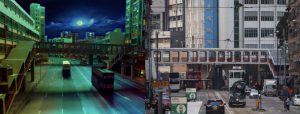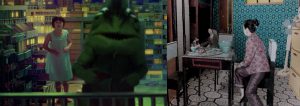Z: Welcome to our podcast, today we are going to talk about architecture in a recent film called Aberdeen. It was directed by Pang Ho-cheung, who has been known for good at discover absurd in mundane reality of everyday life. Eric, Can you tell us more about this storyline of the film?
C: Yes, this film mainly talks a typical Hong Kong family which has misunderstanding between different family members at the beginning. There are three different storylines related to three small families: Wai Ching and Kin Cheung; Cici and Wai Tao as well as Dong and Ta each have their own difficulties. Finally, by the chance saving a stranded whale these family members work together and their misunderstanding is resolved. In this film architecture plays a very important role in storytelling and the director also used an imaginary paper city as a connection between different storylines.

Z: The first shot of the film is Wai Ching looking out at the sea from the fortress, she is smoking and looks distressed. Wai Ching is the tourist guide of hong kong museum of coastal defence. She is experiencing very serious mental stress in the film. And Wai Ching cannot get rid of the pain caused by the misunderstanding with her mother, even though she has passed away for like 10yrs. The camera goes from far to close, and the audience can see the very narrow lookout entrance, the interior of the fortress is rather dark, the sunlight outside forms a contrast between light and dark with the interior. This scene is very short, but it expresses a lot of feelings of the character, eric, can you brief us about it?
C: Sure. As you mentioned, the scene of the fortress has an important role in the narrative of Wai Ching. In this shot, the gloomy, old nature of the fortress is consistent with the distress and disappointment of the characters. Wai Ching’s mental being is also trapped in such a small space, which suggests the mental internal depletion. These photographs were taken during our field trip through a narrow, downward staircase that leads to this location. It is very dark inside and lack of sun light.
Z: not only that, we found the filming location and discovered that after almost 10 years, the outside of the fortress was full of trees and no longer had a direct view of the sea and the old buildings on the other side. In the film, Wai Ching could clearly hear the loud sound of the waves. And the film’s camera shakes at this point, making people feel dizzy. These are the houses on the opposite shore, which are very distinctive. Some houses are built in the sea water, without neat planning, and are of high density. These are the houses where families live. Anyway, the fortress scene also appears in the later plot, eric can you briefly describe it?

C: Sure, the other scene is when Wai Ching is back in the fortress looking for her phone. The two scenes go back and forth, reiterate the knot that Wai Ching has with her mother.
Z: Despite the scene at the fortress, the most impressive architecture element in this film is a model city built from paper. It was shown multiple times throughout the film. Eric, could you tell me more about it?
C: Yes, the model city was dedicatedly built for this film, the production team spent several months on building the model and polishing the details. They hope to make the main street as similar as possible to King’s road from Quarry Bay to North point back in 1980s. As shown here, they integrate different elements along the street such as residential house, skybridge into a compact area where the story take place. Throughout the film, there are several short takes showing the aerial view of the city as well as two longer scenes involve two main characters little pig and Wai Ching respectively.

Z: What do you think this model represent in the film?
C: I think the model is a mirror of Hong Kong in afterlife. When people or their loved pets pass away, they will live in this city made of paper. The first scene of the paper city is introduced when little pig lost her pet Greeny, a chameleon. It is there that she met her Greeny in the dream. The second scene is shown in Wai Ching’s dream, where she met her dead mother who she deeply misunderstood.
Z: That’s very interesting, a mirror city of Hong Kong for afterlife. I noticed that for these two scene, people seems to have different sizes compared with the city, why do you think the director filmed in this way?

C: I believe emotion delivered by these two scenes are different. In the first scene, the main character little pig is missing her pet and friend Greeny. The world of afterlife is shown through the eye of a child with imagination, Greeny became a monster like a Godzilla. Destroying cars and skybridges all along the way. The little pig, as Greeny’s friend, therefore has the similar size as Greeny.
The later scene is to show the fearness and misunderstanding between Wai Ching and her mother.
Wai Ching believes her mother hate her and have the preference over her younger brother. Therefore in the film, Wai Ching appears to be smaller than usual size and even smaller than her mother. To show such differences in size, the director designed a special room with different geometry perspectives to achieve such visual effect.
Z: This is indeed a smart way to integrate emotion into visual language. Since there are two version of Hong Kong in the film. How does the director transit the scene from our city to the paper city?
C: The first transition was made naturally following little pig fall asleep, after she carried Greeny out of her house, the scene shift to the paper city soon after that. In the second transition, the director used transport vehicle to connect the two cities. Wai Ching got on a paper-made taxi and traveled from the museum where she works to North point where her mother used to live. The taxi first travels in the street of real Hong Kong. The scene transition happened soon after the taxi get off the highway from an approach bridge leading to North Point. When filming the second transition, the camera track the taxi all the way. In order to make sure the transition natural, the camera only shows old buildings such as Tong Lous, and also avoid to shoot modernized building a long the trip.
Z: How did you find that?
C: During our field trip, we found that the place where Wai Ching get on the taxi is actually not the entrance of the modernized museum itself. Instead, it was shot before an old shipyard 300m away from the main entrance. When tracking the taxi, it prevent to show any post-modernism high-rise buildings built after 1980s. The director is trying to make the style and age of the buildings consistent between the actual city and the paper city.

Z: Yes and I think that’s the unique part of this film. During our field trip, we have found many special designs that showing the architectures do play an important role in the narrative. Like in this film, the paper city connects the multiple storylines and serves as a prelude to the grand finale.
That’s all about today, Thanks for your watching.
Names:
Chen Sirui 3035532882
Zhang Shiyan 3035772107
You have demonstrated sufficient abilities to elaborate how architecture establishes different ambiences and thus triggers audiences’ emotions in a film. You have also shown your careful analysis focusing on the Paper City and the scenes within it, such as the transition from the paper taxi in reality into the Paper City.
However, certain parts of your analysis are somehow scattered that make listeners difficult to understand the main storyline of the film. You may want to structure your script to enhance coherence.